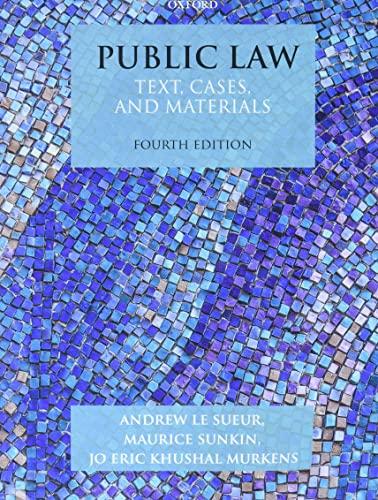Question
BASE ON CHAPTER 1:LEGAL AND CONSTITUTIONAL FOUNDATIONS_OF BUSINESS 1.Define the termlaw. 2.Describe the common feature of all laws, regardless of how they are established. 3.What
BASE ON CHAPTER 1:LEGAL AND CONSTITUTIONAL FOUNDATIONS_OF BUSINESS
1.Define the term"law".
2.Describe the common feature of all laws, regardless of how they are established.
3.What is the difference between primary sources and secondary sources of law?
4.Identify and discuss (in detail) the four primary sources of law.
5.The U.S.A. follows common law tradition.Discuss the concept of common law and precedent. Why is precedent important in judicial decision-making?
6.What is stare decisis?What does it do for the law?Discuss the two main aspects of stare decisis.
7.Is it possible to rule against precedent?Check out the history of Brown v. Board of Education as an example of the Supreme Court overturning its earlier decision in Plessy v. Ferguson.
8.What do the terms controlling precedents and binding authority mean?
9.What guides courts in their decision making when there is no precedent?
10.What does the term "persuasive authority mean?When is it used?
11..What is the difference between remedies in law and remedies in equity?Why is the distinction relevant today?
13.What is cyberlaw?
14.What is a civil law system?
15.What is the highest law of the USA? (Look this up online)
16.What is the highest crime in the USA? (Look this up online)
17.Discuss the following concepts:
Federalism (Federal form of government);
enumerated (delegated) powers and reserved powers;
separation of powers; and
the system of checks and balances.
18.What are the three branches of the US Government?What does each one primarily do? (Look this up online.)
19.Discuss the commerce clause of the U.S. Constitution.
20.What is the intent of this clause?
21.What is the commerce power today?
22.What is the supremacy clause?
23.What is preemption all about?
24.What is the concept of the "dormant" commerce clause in the U.S. Constitution?
25.What is the Bill of Rights? What is the main purpose of the Bill of Rights?
26.What are the protections under each of the 10 amendments that are part of the Bill of Rights?
27.Is it illegal to burn the American Flag?Explain. (Look this up online.)
28.Look at the Beyond Our Borders-The Impact of Foreign Law on the United States Supreme Court.
Do U.S. courts, especially the U.S. Supreme Court, look to laws and court opinions of other nations?
Should they?
29.Discuss Freedom of Speech in detail, which includes symbolic speech, content neutral laws, laws that restrict the content of speech, compelling government interest, corporate political speech, commercial speech unprotected speech, and online obscenity (see Adapting the Law to the Online Environment-Does Everyone Have a Constitutional Right to Use Social Media?)
30.Discuss in detail freedom of religion.Include a discussion of the establishment clause (which I consider freedom from religion) and the free exercise clause (freedom of religion.)
31.What happened in the Trunk v. City of San Diego case (Case Example 1.15 in the Establishment Clause discussion)?
32.What is the purpose of the 14th Amendment? What is the effect of the Fourteenth Amendment?
33.Discuss the Due Process clauses of the 5th and 14th Amendments.
34.Discuss the difference between procedural and substantive due process.
35.What is the main intent of the equal protection clause?Which Amendment contains this clause?
36.What rights are included in the 5th Amendment?
37.Does the Constitution include any provisions regarding the right to privacy?
38.What types of laws give us some rights to privacy?How do they impact the business world?
39.What is the USA Patriot Act?
40.Why is the constitution for Texas so long and so difficult to make changes to it? (Look this up online.)
Step by Step Solution
There are 3 Steps involved in it
Step: 1

Get Instant Access to Expert-Tailored Solutions
See step-by-step solutions with expert insights and AI powered tools for academic success
Step: 2

Step: 3

Ace Your Homework with AI
Get the answers you need in no time with our AI-driven, step-by-step assistance
Get Started


